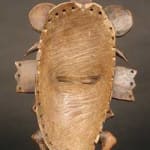Senufo Wooden Kpeliyee Mask, 20th Century CE
Wood
6.75 x 12.5
PF.5886
Further images
Senufo men have their own 'secret' societies, called the Poro, headed by the village elder, in which the sacred knowledge of manhood is taught to young initiates. Before they are...
Senufo men have their own "secret" societies, called the Poro, headed by the village elder, in which the sacred knowledge of manhood is taught to young initiates. Before they are taken into the wilderness to learn the clan wisdom, prospective adolescent are symbolically "killed" to signify the end of their childhood. Upon their return, they are welcomed back into the village as adults with an elaborate ceremony. The most beautiful element of this ceremony is the celebration of the interdependent relationship between man and woman. Young men newly initiated into Poro society wear masks similar to this Kpeliye’e mask. To garner the appreciation of women, these young men, dressed in full, colorful costumes of cloth and raffia to complement their masks, prance gracefully in a masquerade to the beat of pounding drums and dazzling rattles. This Kpeliye’e mask is a fine example. It represents, as all Kpeliye’e masks do, a beautiful, idealized woman. Its face is human in form and its head is crowned with a few pairs of carved ornamentations. One pair is said to represent ears, another horns, while the other is purely decorative. The large central crest covered in five rows of nodules is supposed to represent the pods of the kapok, a tree associated with civilization and human settlement. By each side of the protruding mouth, with teeth visible, spring two curved forms. The Senufo themselves explain that these might represent tassels of hair, or perhaps even legs. To the Senufo, this masks was representative of the wisdom of the sexes, a knowledge we continually struggle to understand today.





